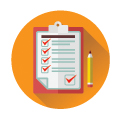20 checks before you launch a website

This checklist gives you 20 checks to think about before you launch a website.
Download the make your website e-book
1. Spellcheck. Grammar check.
 Make sure you check all of your pages for spelling mistakes, typos and punctuation. The eye and mind become accustomed when reading the same text over and over again, so it is a good idea to look for the services of an external proofreader. It is quite affordable and pays off.
Make sure you check all of your pages for spelling mistakes, typos and punctuation. The eye and mind become accustomed when reading the same text over and over again, so it is a good idea to look for the services of an external proofreader. It is quite affordable and pays off.
2. Images. Favicon.
 Now go over your pages once again, comparing the drafts to the final pages, and look for empty image slots. All images must be loading properly and fast. If your images are taking too long, you need to resize them or look for methods for compression. Your favicon must be visible and recognizable. If your logo does not sit well as a favicon, try to customize it to a recognizable symbol. You can even go for a single-colored simple shape that complements your design.
Now go over your pages once again, comparing the drafts to the final pages, and look for empty image slots. All images must be loading properly and fast. If your images are taking too long, you need to resize them or look for methods for compression. Your favicon must be visible and recognizable. If your logo does not sit well as a favicon, try to customize it to a recognizable symbol. You can even go for a single-colored simple shape that complements your design.
3. Layout and style.
 Cross-check your layout and design. For example, if you have a shop, take all your product pages. Are you using the same font? Is the size of the page similar? Is the use of bold or cursive text comparable? Is the number of images or illustrations the same? Trust your gut if the design does not sit well for you.
Cross-check your layout and design. For example, if you have a shop, take all your product pages. Are you using the same font? Is the size of the page similar? Is the use of bold or cursive text comparable? Is the number of images or illustrations the same? Trust your gut if the design does not sit well for you.
Need hosting for your website?
4. Flow.
Visiting your website should be a journey. And your job is to make sure the user arrives at the destination. The homepage should offer the most options and all pages should point to the next step. Have a clear call-to-action.
5. Menu.
Carefully review your head menu. Has every page deserved its place at the top? Are you missing something? Do you have every page your customers are looking for? An About Us, a FAQ, a Blog, a Log In, or maybe a Contact Us page? Does your language switcher work properly?
6. Hyperlinks.
Better check your links, too. And not just in your texts. Your images or icons can also lead to other pages. Do they? While you are at it, check if your anchor text is keyword optimized.
7. SEO.
 Search Engine Optimization. Your URLs must be meaningful. Your headlines and the first lines of your paragraphs must contain your most important keywords. Check your keyword density. Your metadata. The text behind your images. See if your Google snippets are on point.
Search Engine Optimization. Your URLs must be meaningful. Your headlines and the first lines of your paragraphs must contain your most important keywords. Check your keyword density. Your metadata. The text behind your images. See if your Google snippets are on point.
8. Social media ready.
Check your open graph tags to make sure your pages will appear right when you share them in social media.
9. Google Analytics.

Make sure your Google Analytics code is integrated and working. You don’t want to miss detecting the data within the first days of your launch.
10. Google Search Console.
Sign up for GSC and tell Google which content should be visible and which should not be available to the search engine. Now you are ready to monitor your website’s search result performance.
11. Responsive design.

Use a reliable tool to review your pages and functionalities to be responsive to different devices and layouts. The Responsinator is free and easy to use.
12. Browsers.
If you have an old website, better check your Google Analytics and focus on the browsers your audience prefers. If not, better cover the minimum: Chrome, Firefox, Safari, Edge and Opera. In each of them, check your layouts, your contact forms and the essential functionality.
13. Speed.
 Use a reliable tool to review your page for load times. Google Developers’ Page Speed Insights will test the speed of your pages in their mobile and desktop versions and will give you advice how to improve your speed score.
Use a reliable tool to review your page for load times. Google Developers’ Page Speed Insights will test the speed of your pages in their mobile and desktop versions and will give you advice how to improve your speed score.
14. Contact forms.
 Fill in and submit one of each available forms on your site. Try omitting the required fields. Proofread your ‘incomplete form’ and ‘sent successfully’ messages. Check if the generated emails contain all information.
Fill in and submit one of each available forms on your site. Try omitting the required fields. Proofread your ‘incomplete form’ and ‘sent successfully’ messages. Check if the generated emails contain all information.
15. Custom error pages.
Make sure you have custom error pages, most importantly, a 404 error page. Do they give the proper message? Is it complete and easy to understand?
16. Customized Under Maintenance page.
Within the first week from a fresh launch you are statistically most likely to notice any significant issues. Have a custom Under Maintenance page ready if you suddenly need to jump in and fix something.
17. Cleanup.
Clean up your files, your folders, or your code. After your final check you might have uploaded images you are not using or entire pages you have later given up. Cleanup your CSS code. Clean up your code comments.
18. Backups.
Make sure your hosting provider will create regular backups for your masterpiece.
19. Plan.

What is your vision to develop the website further? If you have any sort of regular content, such as blog posts, have a couple drafts in advance. If it is possible, schedule them to be published regularly.
20. Ask for help.
Consider creating a sticky message or a popup informing your audience the website is new, to apologize if there are any issues, and provide a contact for feedback.


